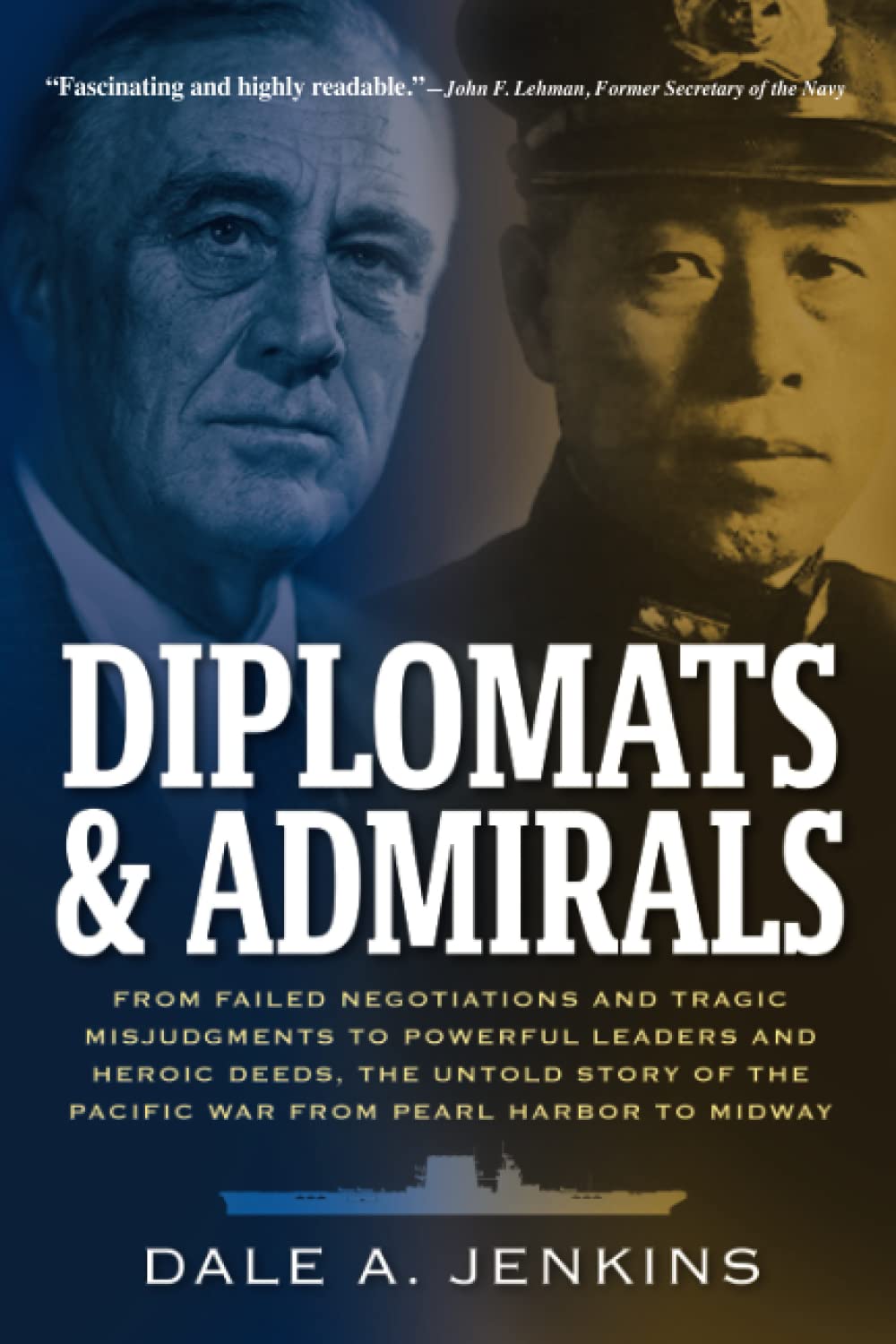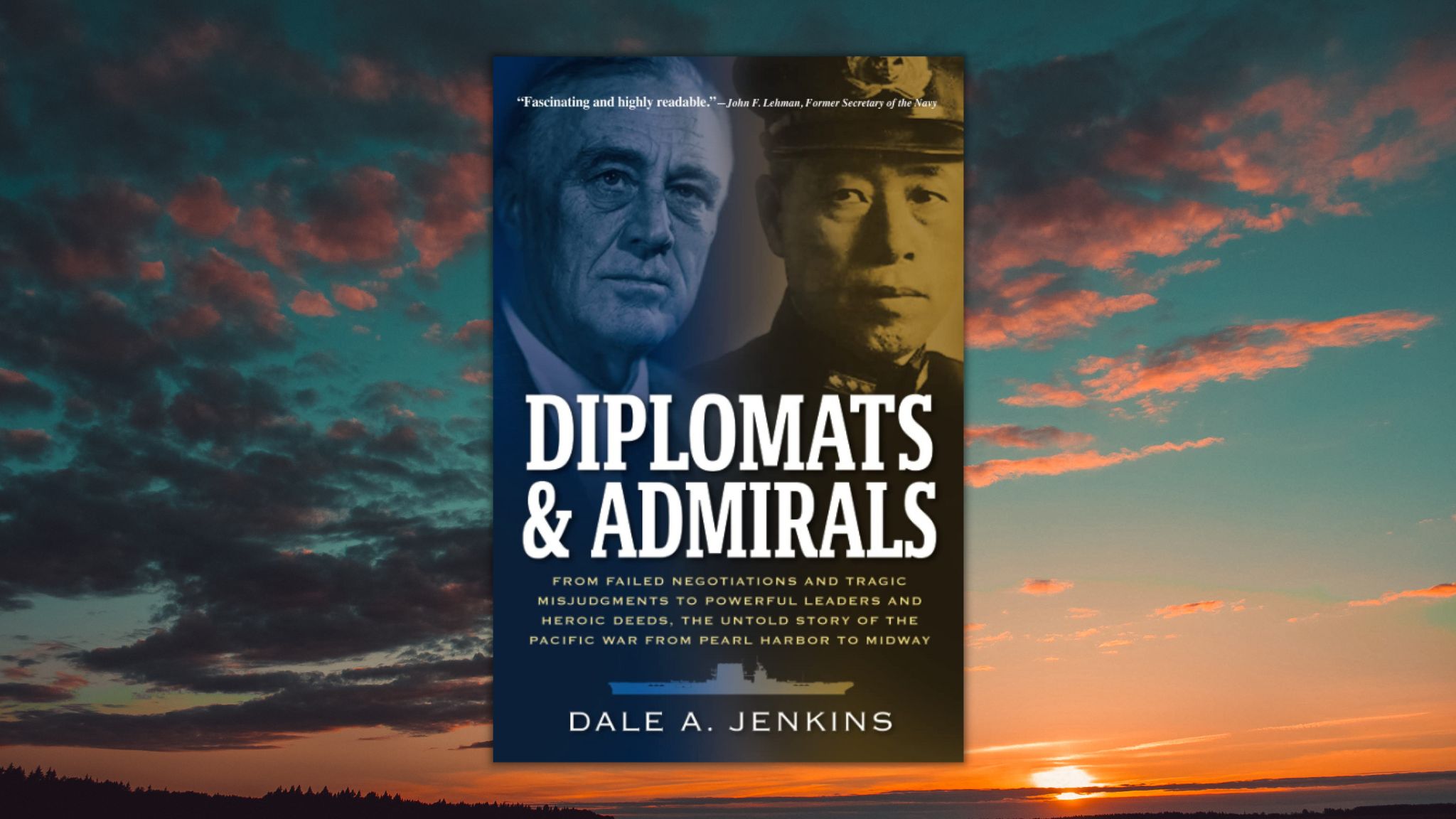Diplomats and Admirals by Dale Jenkins
What's It About?
Diplomacy & Admirals is a rigorous retelling of Japanese and American diplomacy in the days, months, and years leading up to the biggest war of the twentieth century, as well as the wartime acts of heroism that decided the fate of two nations. WWII fans should not miss this crisp, authoritative account.Could America have avoided war with Japan in 1941? That is the intriguing question that powers this compelling re-interpretation of diplomacy and military decisions in Diplomats & Admirals by former American naval officer and historian Dale A. Jenkins. Focusing solely on events between July 1941 to June 1942, Jenkins zeroes in on the disastrous misjudgments and mangled communications that bedeviled the upper echelons of power in Japan and America.
Jenkins positions his study as a “counter-revisionist” work that resurrects key sources of materials and original documents (many newly declassified) to blow the dust off “aging memories” and tell a new story that suggests the Japanese attack on Pearl Harbor in December 1941 could have been averted if “essential interaction and communications” between senior civilian and military leaders had not failed so shockingly.
After a robust contextual analysis of the tense diplomatic interactions between the United States and Japan in the run-up to hostilities, Jenkin moves into a critique of President Franklin D. Roosevelt’s inner circle of Cabinet members who informally coalesced into his War Council: Secretary of State Cordell Hull, Secretary of War Henry L. Stimson, Secretary of the Navy Frank Knox, and Secretary of the Interior Harold L. Ickes. These were the men tasked with advising the president on the correct course of action—who often failed, in Jenkins piercing conclusions.
A ROBUST ANALYSIS
Citing a “massive communications gap at the highest levels” of the U.S. government—specifically between the civilian War Council and senior naval officers—as the main reason behind America’s “muddled diplomacy” with Japan, Jenkins pinpoints the discrepant understandings of Japan’s military strength vis a vis America’s war readiness. The War Council of Hull, Stimson, Knox, and Ickes believed that if the newly belligerent Japanese went to war with the U.S., it would constitute merely a short naval campaign in the southern Pacific. But as Jenkins shows:
“This belief shaped the negotiations with the Japanese diplomats but was directly contrary to the views of the armed forces chiefs, General [George] Marshall and Admiral [Harold] Stark.”
Indeed, as Jenkins highlights plentifully throughout the first half of his engaging book, Japan was in a much stronger military position than the War Council conceived. He says that by 1941, Japan was “the most powerful navy in the world” and the U.S. Navy was quite aware of its composition. “How,” Jenkins asks, “the State Department, and specifically Hull, was not aware of this information is incredible.”Jenkins believes this head-scratching breakdown in communication had massive implications:
“This woeful ignorance in the United States cabinet regarding the Japanese navy, and the influence this ignorance had on the decisions that led to Pearl Harbor, is staggering.”
But Jenkins is just as strong a critic of Japan’s diplomatic mistakes, as well. The aggressive and expansionist foreign minister Matsuoka Yosuke does not come off well, as Jenkins takes exquisite care to contrast Matsuoka’s anti-American positions with the more peaceful overtures of Prime Minister Konoe (who urgently worked to avert war with the U.S.).
A CRISP, AUTHORITATIVE ACCOUNT
“Matsuoka … played an aggressive diplomatic game. His moves to create an alliance against the United States … had a major flaw: Japan imported 90 percent of its oil, almost all of it from the United States … Had no one in the Japanese government considered that?”
Jenkins clearly denotes the role that Japanese expansion played in the run-up to war, citing the “Japanese cabinet’s failure to reconsider Japan’s expansion policy” in the face of expected opposition from Great Britain and the United States “as a huge lost opportunity to avoid a Pacific War.”
Jenkins’ command of original source material buttresses his arguments effectively, although not every document or treaty stipulations needed to be reproduced in length—Jenkins’s expert synthesis of the material is enough for the reader. Also, the first half of the book seems disconnected from the second half, which relates—albeit thrillingly—the sea battles that ultimately decided the Pacific War: Pearl Harbor, Wake Island, the Coral Sea, and Midway, to name the most consequential.
Diplomacy & Admirals is a rigorous retelling of Japanese and American diplomacy in the days, months, and years leading up to the biggest war of the twentieth century, as well as the wartime acts of heroism that decided the fate of two nations. WWII fans should not miss this crisp, authoritative account.
About the author:
Dale Jenkins has had a lifelong interest in the Navy and international affairs. He is a former US Navy officer who served on a destroyer in the Pacific and for a time was home-ported in Yokosuka, Japan. Pacific Fleet commitments took him to the Philippines, Taiwan, South Korea, Hong Kong, and Singapore. While on active duty, he was awarded the Navy/Marine Corps Expeditionary Medal. His business career was primarily in international banking, and he was also a staff director at the Council on Foreign Relations in New York. Dale currently serves on the Samuel Eliot Morison Committee of the Naval Order of the United Sates, New York, and as a Regional Director of the Naval War College Foundation. As a result of his active-duty experience and new revelations, Dale provides insight into the diplomacy and strategies of the Pacific region. He has degrees in history and business from Harvard and Columbia.





